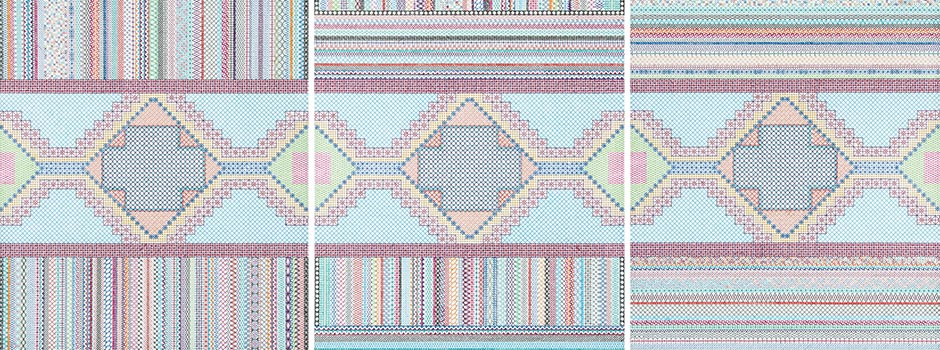
Solo Show at the Isabelle van den Eynde Gallery in Dubai Nargess Hashemi: ‘The Pleasure in Boredom’
Feb 22, 2014 Exhibition

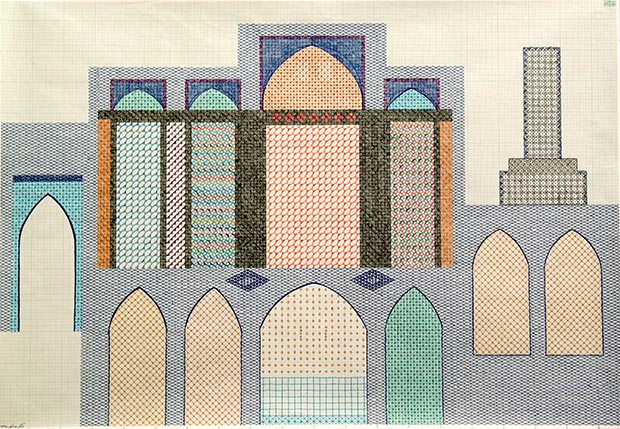 Nargess Hashemi / Carpet, 2013, Pen on graph paper / Courtesy of Isabelle van den Eynde Gallery and the Artist
Nargess Hashemi / Carpet, 2013, Pen on graph paper / Courtesy of Isabelle van den Eynde Gallery and the Artist
The new pieces produced on simple graph paper were inspired by art historian Ernst Gombrich’s ideas on the art and psychology of doodling as well as the artist’s own long obsession with automatic drawing. Made using the simplest materials and process, the overall impression is, however, one of structure and sophistication. The patterns that were designed and drawn spontaneously are quite complicated, suggesting that Nargess has taken the repetitive element of doodling to a whole new level and perhaps even redefined automatic drawing which doesn’t usually possess such graphic rationality.
 Nargess Hashemi / Carpet, 2013, Pen on graph paper, 70x100 cm / Courtesy of Isabelle van den Eynde Gallery and the Artist
Nargess Hashemi / Carpet, 2013, Pen on graph paper, 70x100 cm / Courtesy of Isabelle van den Eynde Gallery and the Artist
The carpet pieces can be considered a new departure for Hashemi even if they share many elements with her narrative work. They are effectively, according to the artist, a natural evolution. When asked how pattern came to be so central, Nargess’ reply also sheds light on the internal visual logic of her practice, "In each series, I try to have a closer view of details seen in earlier series and to actually focus in on them to have a close-up image like the zoom in photography. The importance of details and patterns became my purpose more than the narrative elements. So the pieces are more like contemporary art."
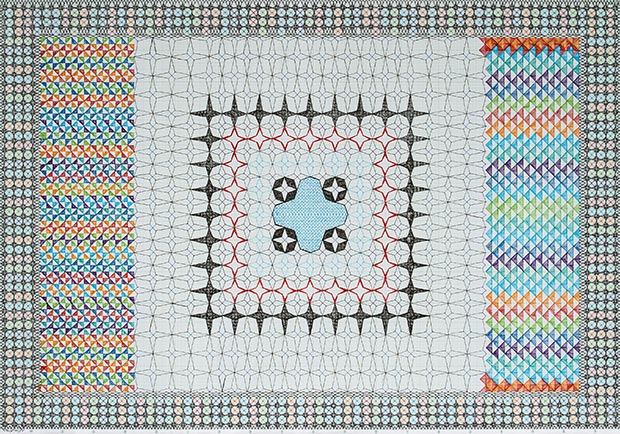 Nargess Hashemi / Carpet, 2013, Pen on graph paper, 70x100 cm / Courtesy of Isabelle van den Eynde Gallery and the Artist
Nargess Hashemi / Carpet, 2013, Pen on graph paper, 70x100 cm / Courtesy of Isabelle van den Eynde Gallery and the Artist
The ballpoint pen carpets relate to major themes running throughout Hashemi’s work, such as home, self, and identity. Pattern, which continues to be ever-present in Iranian homes and cities, recurs often and forms one of the ways the artist comments on her home country. The patterns found in the carpet pieces could refer to other kinds of textiles or media such as architectural decoration or metalwork; it is the title that situates them as ‘carpets’. Hashemi speaks of the ubiquity of carpets in Iran, particularly in nomadic contexts, confirming that the carpet motif in her work acts as a visual metaphor for home and the feeling of confinement it sometimes implies.
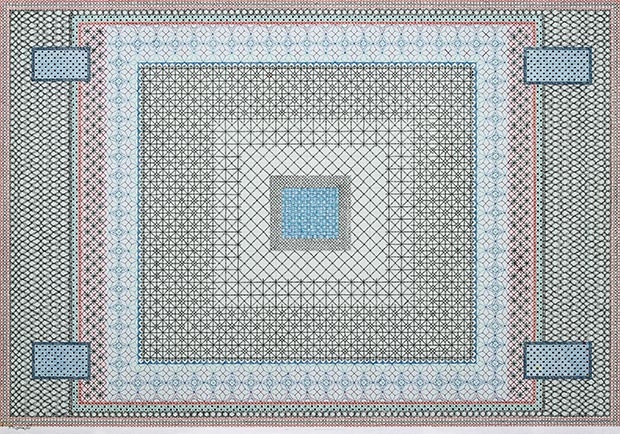 Nargess Hashemi / Carpet, 2013, Pen on graph paper, 70x100 cm / Courtesy of Isabelle van den Eynde Gallery and the Artist
Nargess Hashemi / Carpet, 2013, Pen on graph paper, 70x100 cm / Courtesy of Isabelle van den Eynde Gallery and the Artist
 Nargess Hashemi / Carpet, 2013, Pen on graph paper, Quadriptych of six panel, each panel 70x100 cm, overall 140x200 cm / Courtesy of Isabelle van den Eynde Gallery and the Artist
Nargess Hashemi / Carpet, 2013, Pen on graph paper, Quadriptych of six panel, each panel 70x100 cm, overall 140x200 cm / Courtesy of Isabelle van den Eynde Gallery and the Artist
The new abstract works, like the title of the show, exhibit the same humor as the earlier domestic scenes and therefore also both challenge the seriousness of art and express the artist’s ambivalence towards domesticity. However, the beauty of these ‘doodled’ carpets seems to override the tongue-in-cheek elements. There is something about their aesthetic, abstraction or process that lessens the tensions and contrasts between past and present, public and private or art and life that characterize Hashemi’s art; the carpets –or more precisely the effect of their patterns—open up a new space for the viewer that moves beyond critique.
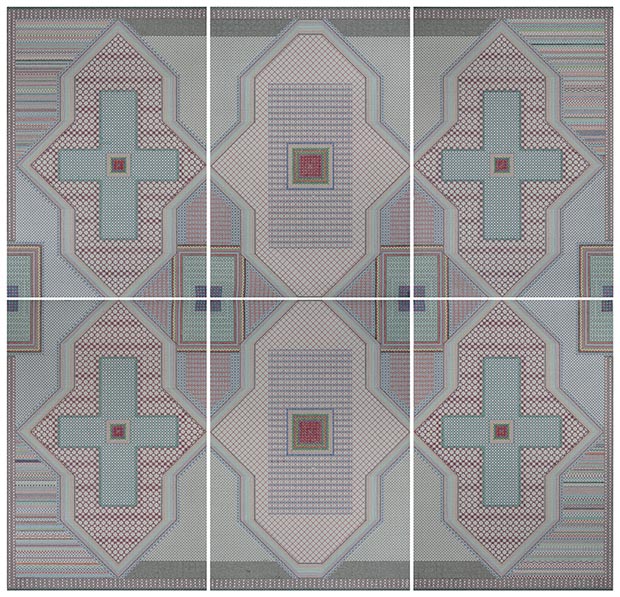 Nargess Hashemi / Carpet, 2013, Pen on graph paper, Poliptych of six panel, each panel 100x70 cm, overall 100x210 cm / Courtesy of Isabelle van den Eynde Gallery and the Artist
Nargess Hashemi / Carpet, 2013, Pen on graph paper, Poliptych of six panel, each panel 100x70 cm, overall 100x210 cm / Courtesy of Isabelle van den Eynde Gallery and the Artist
 Nargess Hashemi / Carpet, 2013, Pen on graph paper, Triptych, each panel 100x70 cm, overall 100x210 cm / Courtesy of Isabelle van den Eynde Gallery and the Artist
Nargess Hashemi / Carpet, 2013, Pen on graph paper, Triptych, each panel 100x70 cm, overall 100x210 cm / Courtesy of Isabelle van den Eynde Gallery and the Artist
Hashemi likes to test standard notions of artistic beauty and mastery. This is apparent in the carpet pieces, but is even most apparent in the new textile works, each one simply entitled ‘Rug'. Contrary to the carpets, the fiber works do not follow any pattern; their multi-colored organic forms seem effectively to constitute three-dimensional doodling. Speaking about these pieces, the artist says, "The 'macramé' idea was also happening during working on the carpet series. I did not plan for them or give them a specific idea or meaning. I just wanted to break the classic pattern," while also adding "but my works have never been anti-aesthetic". These soft sculptures with their non-linear shapes perhaps best reveal Hashemi’s confidence as an artist. The viewer can’t help but share in the artist’s (and gallery’s) joy of showing these handcrafted artefacts on pedestals in the spaces of contemporary art.
Throughout her practice, Hashemi brings together different elements, not so much to oppose or resolve them than to produce new ways of looking and thinking. The artist’s uses the same analogy when discussing the evolution of her work, describing how the recent series provides 'a new kind of view' on the work that came before it. This young talented artist is always moving ahead, forging her own path or, to use her own words, "Life is going forward and I'm trying to discover and create new artwork. I’m not interested in repeating myself." It will be exciting to see where Hashemi takes us next.
Comments
Add a comment